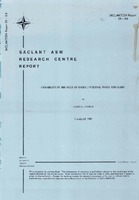| dc.description.abstract | An experiment was performed in the Gulf of Cadiz during June 1977, with the objective of separating oceanic variability due to internal waves from that due to inhomogeneities of the water. A CTD which oscillates in depth between 120 and 170 m while towed horizontally provided vertical (x,z) sections of temperature, salinity, density and sound velocity within this depth range. The density field is adequately resolved over long tow paths to give internal wave records in which the usual contamination due to horizontal and vertical thermal structure is minimized. Identifying the effects of internal waves by their influence on the density field permits their removal from the records, leaving a clear picture of the variability within the medium due simply to spatial differences in the physical makeup of the water. The picture of the area investigated is one in which there are large cores of relatively cold fresh water scattered throughout a more uniform warmer, saltier background. The size and expected persistence of such cores, together with the fact that their boundaries are marked by relatively strong gradients, add interest to their presence in the sound speed field. They account for only about one-fifth of the overall sound speed variance, but they may dominate it locally in the form of well-defined ducts tens of meters thick and several kilometers wideAn experiment was performed in the Gulf of Cadiz during June 1977, with the objective of separating oceanic variability due to internal waves from that due to inhomogeneities of the water. A CTD which oscillates in depth between 120 and 170 m while towed horizontally provided vertical (x,z) sections of temperature, salinity, densityon, with increased proximity to the coast the internal wave spectrum changes shape in a way that indicates a shift of energy to lower horizontal wavenumbers. | |
